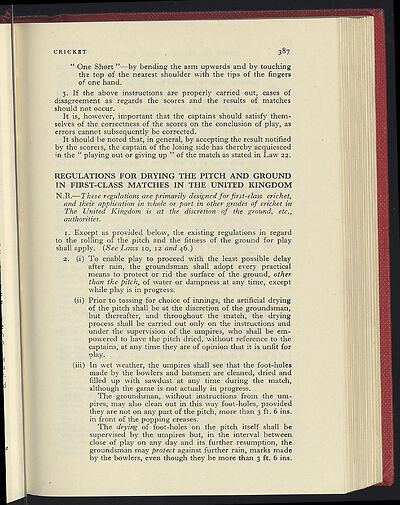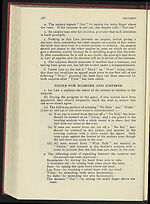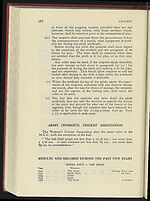1957-58
(405)
Download files
Complete book:
Individual page:
Thumbnail gallery: Grid view | List view

CRICKET
3&]
" One Short "—by bending the arm upwards and by touching
the top of the nearest shoulder with the tips of the fingers
of one hand.
3. If the above instructions are properly carried out, cases of
disagreement as regards the scores and the results of matches
should not occur.
It is, however, important that the captains should satisfy them-
selves of the correctness of the scores on the conclusion of play, as
errors cannot subsequently be corrected.
It should be noted that, in general, by accepting the result notified
by the scores s, the captain of the losing side has thereby acquiesced
in the " playing out or giving up " of the match as stated in Law
22.
REGULATIONS FOR DRYING THE PITCH AND GROUND
IN FIRST-CLASS MATCHES IN THE UNITED KINGDOM
N.B.
—These regulations are primarily designed for first-class cricket,
and their application in whole or part in other grades
of
cricket in
The United Kingdom is at the discretion of the ground, etc.,
authorities.
t
1
1
a
I.
Except as provided below, the existing regulations in regard
to the rolling of the pitch and the fitness of the ground for play
shall apply.
(See Laws io,
12
and 46.)
2.
(i) To enable play to proceed with the least possible delay
after rain, the groundsman shall adopt every practical
means to protect or rid the surface of the ground,
other
than the pitch,
of water or dampness at any time, except
while play is in progress.
(ii) Prior to tossing for choice of innings, the artificial drying
of the pitch shall be at the discretion of the groundsman,
but thereafter, and throughout the match,. the drying
process shall be carried out only on the instructions and
under the supervision of the umpires, who shall be em-
powered to have the pitch dried, without reference to the
captains, at any time they are of opinion that it is unfit for
play.
(iii) In wet weather, the umpires shall see that the foot-holes
made by the bowlers and batsmen are cleaned, dried and
filled up with sawdust at any time during the match,
although the game is not actually in progress.
The groundsman, without instructions from the um-
pires, may also clean out in this way foot-holes, provided
they are not on any part of the pitch, more than 3 ft. 6 ins.
in front of the popping creases.
The
drying
of foot-holes on the pitch itself shall be
supervised by the umpires but, in the interval between
close of play on any day and its further resumption, the
groundsman
may
protect
against further rain, marks made
by the bowlers, even though they be more than 3 ft. 6 ins.
3&]
" One Short "—by bending the arm upwards and by touching
the top of the nearest shoulder with the tips of the fingers
of one hand.
3. If the above instructions are properly carried out, cases of
disagreement as regards the scores and the results of matches
should not occur.
It is, however, important that the captains should satisfy them-
selves of the correctness of the scores on the conclusion of play, as
errors cannot subsequently be corrected.
It should be noted that, in general, by accepting the result notified
by the scores s, the captain of the losing side has thereby acquiesced
in the " playing out or giving up " of the match as stated in Law
22.
REGULATIONS FOR DRYING THE PITCH AND GROUND
IN FIRST-CLASS MATCHES IN THE UNITED KINGDOM
N.B.
—These regulations are primarily designed for first-class cricket,
and their application in whole or part in other grades
of
cricket in
The United Kingdom is at the discretion of the ground, etc.,
authorities.
t
1
1
a
I.
Except as provided below, the existing regulations in regard
to the rolling of the pitch and the fitness of the ground for play
shall apply.
(See Laws io,
12
and 46.)
2.
(i) To enable play to proceed with the least possible delay
after rain, the groundsman shall adopt every practical
means to protect or rid the surface of the ground,
other
than the pitch,
of water or dampness at any time, except
while play is in progress.
(ii) Prior to tossing for choice of innings, the artificial drying
of the pitch shall be at the discretion of the groundsman,
but thereafter, and throughout the match,. the drying
process shall be carried out only on the instructions and
under the supervision of the umpires, who shall be em-
powered to have the pitch dried, without reference to the
captains, at any time they are of opinion that it is unfit for
play.
(iii) In wet weather, the umpires shall see that the foot-holes
made by the bowlers and batsmen are cleaned, dried and
filled up with sawdust at any time during the match,
although the game is not actually in progress.
The groundsman, without instructions from the um-
pires, may also clean out in this way foot-holes, provided
they are not on any part of the pitch, more than 3 ft. 6 ins.
in front of the popping creases.
The
drying
of foot-holes on the pitch itself shall be
supervised by the umpires but, in the interval between
close of play on any day and its further resumption, the
groundsman
may
protect
against further rain, marks made
by the bowlers, even though they be more than 3 ft. 6 ins.
Set display mode to:
![]() Universal Viewer |
Universal Viewer | ![]() Mirador |
Large image | Transcription
Mirador |
Large image | Transcription
| Games and sports in the army > 1957-58 > (405) |
|---|
| Permanent URL | https://digital.nls.uk/248856262 |
|---|
| Description | 'Games and Sports in the Army' was an annual publication produced by the British War Office between the 1930s and 1960s. This included the Second World War. It outlines the rules and regulations for games and sports played by members of the armed forces. It features names and photographs of team members, and examples of contemporary advertising. |
|---|---|
| Shelfmark | GWB.52 |

